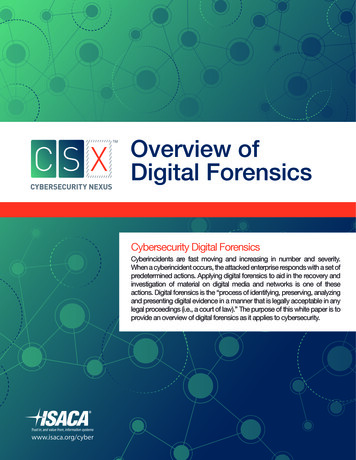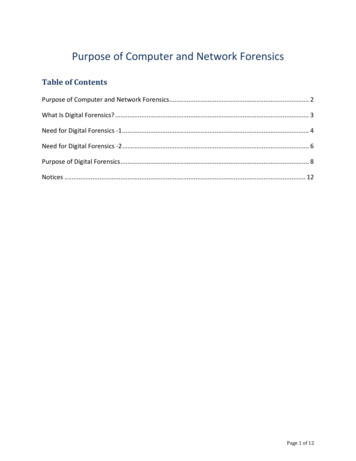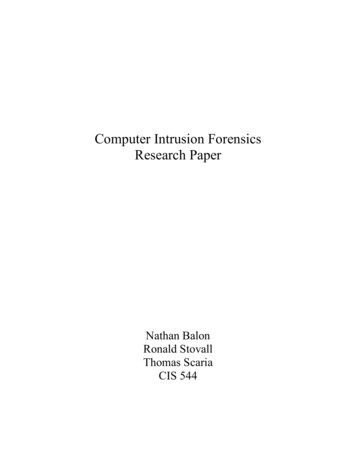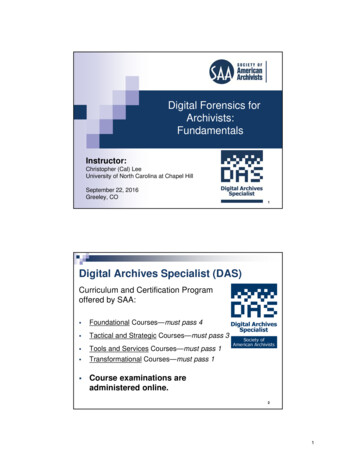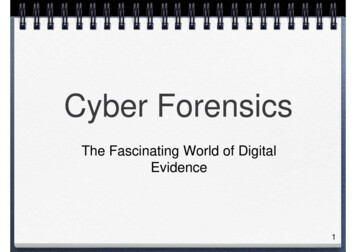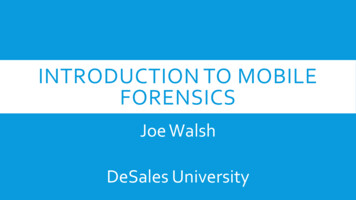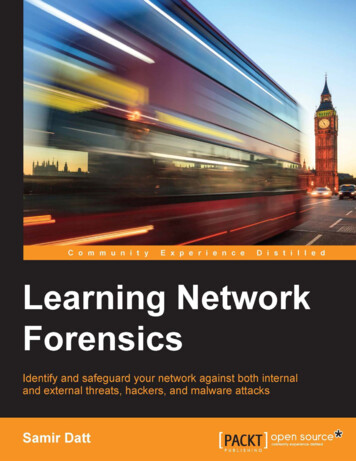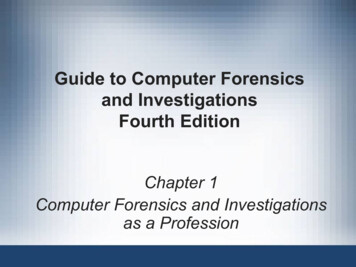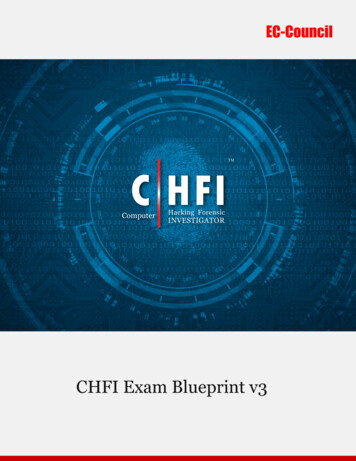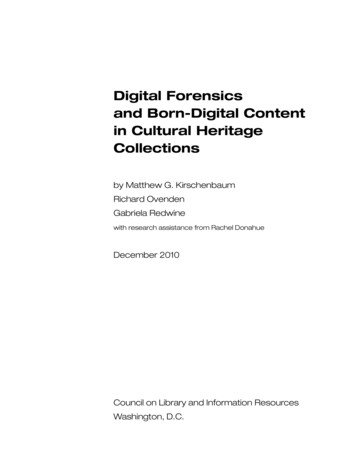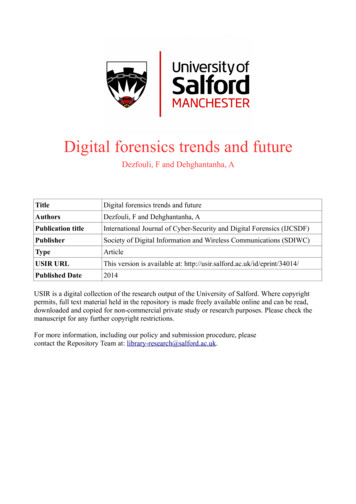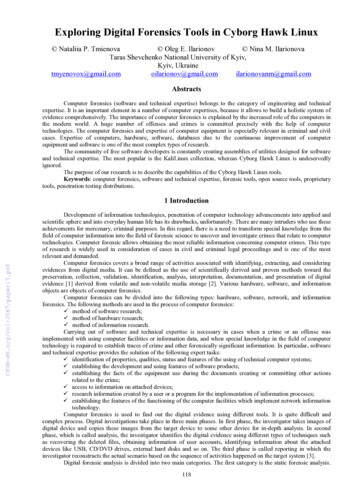
Transcription
Exploring Digital Forensics Tools in Cyborg Hawk Linux Nataliia P. Tmienova Oleg E. Ilarionov Nina M. IlarionovaTaras Shevchenko National University of Kyiv,Kyiv, ionovanm@gmail.comAbstractsComputer forensics (software and technical expertise) belongs to the category of engineering and technicalexpertise. It is an important element in a number of computer expertises, because it allows to build a holistic system ofevidence comprehensively. The importance of computer forensics is explained by the increased role of the computers inthe modern world. A huge number of offenses and crimes is committed precisely with the help of computertechnologies. The computer forensics and expertise of computer equipment is especially relevant in criminal and civilcases. Expertise of computers, hardware, software, databases due to the continuous improvement of computerequipment and software is one of the most complex types of research.The community of free software developers is constantly creating assemblies of utilities designed for softwareand technical expertise. The most popular is the KaliLinux collection, whereas Cyborg Hawk Linux is undeservedlyignored.The purpose of our research is to describe the capabilities of the Cyborg Hawk Linux tools.Keywords: computer forensics, software and technical expertise, forensic tools, open source tools, proprietarytools, penetration testing distributions.1 IntroductionDevelopment of information technologies, penetration of computer technology advancements into applied andscientific sphere and into everyday human life has its drawbacks, unfortunately. There are many intruders who use theseachievements for mercenary, criminal purposes. In this regard, there is a need to transform special knowledge from thefield of computer information into the field of forensic science to uncover and investigate crimes that relate to computertechnologies. Computer forensic allows obtaining the most reliable information concerning computer crimes. This typeof research is widely used in consideration of cases in civil and criminal legal proceedings and is one of the mostrelevant and demanded.Computer forensics covers a broad range of activities associated with identifying, extracting, and consideringevidences from digital media. It can be defined as the use of scientifically derived and proven methods toward thepreservation, collection, validation, identification, analysis, interpretation, documentation, and presentation of digitalevidence [1] derived from volatile and non-volatile media storage [2]. Various hardware, software, and informationobjects are objects of computer forensics.Computer forensics can be divided into the following types: hardware, software, network, and informationforensics. The following methods are used in the process of computer forensics: method of software research; method of hardware research; method of information research.Carrying out of software and technical expertise is necessary in cases when a crime or an offense wasimplemented with using computer facilities or information data, and when special knowledge in the field of computertechnology is required to establish traces of crime and other forensically significant information. In particular, softwareand technical expertise provides the solution of the following expert tasks: identification of properties, qualities, status and features of the using of technical computer systems; establishing the development and using features of software products; establishing the facts of the equipment use during the documents creating or committing other actionsrelated to the crime; access to information on attached devices; research information created by a user or a program for the implementation of information processes; establishing the features of the functioning of the computer facilities which implement network informationtechnology.Computer forensics is used to find out the digital evidence using different tools. It is quite difficult andcomplex process. Digital investigations take place in three main phases. In first phase, the investigator takes images ofdigital device and copies these images from the target device to some other device for in-depth analysis. In secondphase, which is called analysis, the investigator identifies the digital evidence using different types of techniques suchas recovering the deleted files, obtaining information of user accounts, identifying information about the attacheddevices like USB, CD/DVD drives, external hard disks and so on. The third phase is called reporting in which theinvestigator reconstructs the actual scenario based on the sequence of activities happened on the target system [3].Digital forensic analysis is divided into two main categories. The first category is the static forensic analysis.118
During this analysis, all the target devices that are required in the analysis are shutdown. The second category is liveanalysis. During this type of analysis, the system stays in the boot mode [4] to acquire pertinent information from thephysical memory content.Live analysis aims at gathering evidence from systems using different operations and techniques related toprimary memory content. Live forensic is the most challenging kind of digital forensic investigations. To perform thelive forensics, it is vital to understand the basic techniques and tools used in digital forensics. The investigator needs toacquire the complete image of a computer usage history as well as the current state through live forensic analysis tools.Though static analysis is kind of a developed part of digital forensics, but other techniques related to live analysis needto be developed to mitigate its weaknesses [3].Classifications of computer forensics tools include open source, proprietary, hardware, software, specialpurpose and general purpose [5]. Each tool has its own advantages and disadvantages. The choice of forensics toolsdepends on the nature of the studying, the obtained results, the requirements for safety and economic efficiency of thetool.Brian Career [6] reports that open source tools are as effective and reliable as proprietary tools. Manson and histeam [7] compared one open source tool and two commercial tools. They found that all three tools produced the sameresults with different degree of difficulty.2 Description of the most popular tools designed for carrying out software and technicalexpertiseThe community of free software developers is constantly creating assemblies of utilities designed for softwareand technical expertise. A comprehensive review of the top twenty open source free computer forensics investigationtools can be found in [8]. For a list of proprietary computer forensics tools see [9] and [10].The most popular assemblies of utilities intended for carrying out software and technical expertise are:- Kali Linux [11] – Kali Linux is an open source project that is maintained and funded by Offensive Security,a provider of world-class information security training and penetration testing services.- CAINE [12] (Computer Aided Investigative Environment) – CAINE is the Linux distro created for digitalforensics. It offers an environment to integrate existing software tools as software modules in a user friendlymanner. This tool is open source.- DEFT [13] (Digital Evidence & Forensic Toolkit) – The Linux distribution DEFT is made up of a GNU /Linux and DART (Digital Advanced Response Toolkit), suite dedicated to digital forensics and intelligenceactivities.- PHLAK [14] (Professional Hacker’s Linux Assault Kit) – PHLAK is a modular LiveCD Linux distributionwith a focus on pen-testing, forensics, and network analysis. It includes two lightweight GUIs (XFCE4 andFluxbox) and loads of tools, including crackers, sniffers, MITM utilities, and data recovery and duplicationutilities.- Cyborg Hawk Linux [15] – Cyborg Hawk Linux is a Ubuntu based Linux Hacking Distro also known as aPentesting Linux Distro it is developed and designed for ethical hackers and penetration testers. Cyborg HawkDistro can be used for network security and assessment and also for digital forensics. It also has various toolssuited to the testing of Mobile Security and Wireless infrastructure.- BackTrack 5 R3[16]–BackTrack is intended for all audiences from the most savvy security professionals toearly newcomers to the information security field. BackTrack promotes a quick and easy way to find andupdate the largest database of security tools collection to-date.- Parrot Security OS [17] – Parrot Security OS is a cloud friendly operating system designed for Pentesting,Computer Forensic, Reverse engineering, Hacking, Cloud pentesting, privacy/anonimity and cryptography.Based on Debian and developed by Frozenbox network.- BackBox Linux[18]–BackBox is a Linux distribution based on Ubuntu. It has been developed to performpenetration tests and security assessments. Designed to be fast, easy to use and provide a minimal yet completedesktop environment, thanks to its own software repositories, always being updated to the latest stable versionof the most used and best known ethical hacking tools.The using of assembly, rather than individual software tools, can improve reliability, safety and performance.The most popular compilation is the KaliLinux, which contains about 300 utilities, whereas Cyborg HawkLinux [15], which contains more than 800 tools, is undeservedly ignored.The purpose of our research is to describe the capabilities of the Cyborg Hawk Linux tools.3 Our Virtual Machine PlatformCyborg Hawk is a Linux based operating system that comes with a rich repository of security and forensicstools. The computer forensics tools are grouped into several categories. We use the forensics tools within the CyborgHawk.VMware Workstation is a hypervisor that runs on 64-bit computers [19]. It enables us to set up multiple virtualmachines and network them together. Each virtual machine can execute on different distribution of Linux operating119
system. VMware Workstation is proprietary software but we used the trail version for free. Below are the steps forsetting up the platform for our experiment.1. Install VMware Workstation on a machine;2. Create a virtual machine on the VMware workstation;3. Install Cyborg Hawk Linux on the virtual machine;4. Launch Cyborg Hawk Linux from the virtual machine;5. From the list, select forensics and then select a tool.4 Description of the Cyborg Hawk Linux toolsThe Cyborg Hawk Linux disk image was investigated on a VMware Workstation virtual machine running on a64-bit computer.There are 15 classes in the Cyborg Hawk Linux software analysis toolkit, each of which is divided intocategories and subcategories that contain different number of utilities (table 1).Several utilities have been selected in each category. For each of them we investigated its purpose, sequenceand results of work on our virtual machine. One of the conclusions of the studying is that many utilities perform severalfunctions and thus they belong to different classes and categories in the collection. Therefore, the number of originalprograms is much smaller than were stated by the developers of the assembly. In addition, a significant limitation inusing of the assembly is that it is only designed to work with 64-bit processors.5 Forensics Tools ExperimentThere are several categories of computer forensic tools in the disk image of Cyborg Hawk Linux v1. Somecategories have several tools. In the following subsections we will study the tools for Forensics.5.1 AcquisitionTwenty one tools of this category are divided into 10 groups.Let's consider the basic packages of tools.AFF Package (affcat, affconvert) orthe Advanced Forensics Format (AFF).AFF was created as an open andextensible file format for storing disk images and associated metadata. The goal was to create a disk imaging formatthat would not block users into their proprietary format, which can limit its analysis. The open standard allowsresearchers use their preferred tools for solving crimes, collecting information and resolving security incidents quicklyand efficiently. The format was implemented in AFFLIB which was distributed with an open source license.Img package(img cat, img stat) outputs the contents of an image file. Image files that are not raw will haveembedded data and metadata. Img cat will output only the data. This allows you to convert an embedded format to rawor to calculate the MD5 hash of the data by piping the output to the appropriate tool.Img package displays the contents of the image file. Image files that are not raw will have built-in data andmetadata. Img cat will return only data. This allows converting the built-in format to raw or calculating the MD5 hashof the data by submitting the output to the appropriate tool.TSK KIT(tsk comparedir, tsk gettimes, tsk loaddb, tsk recover)– compare the contents of a directory with thecontents of an image or local device.Sleuth Kit (TSK) allows exploring the compromised file system of a computer.TSK is a collection of UNIX command-line tools that can analyze NTFS, FAT, FFS, EXT2FS, and EXT3FS filesystems. TASK reads and processes the file system structures independently, so the file system of the operating systemdoes not need support.5.2 CryptographyThere are 4 tools in this category (Luks-Ops, TrueCrack, TrueCrypt, Tcpcryptd).TrueCrypt is a program for installing and maintaining a drive immediately. Immediate encryption means thatthe data is automatically encrypted or decrypted immediately before downloading or saving it without user intervention.Any data stored on the encrypted volume can be read (decrypted) without using the correct password or the correctencryption key. The TrueCrypt volume before decryption is nothing more than a series of random numbers.5.3 Data recoveryThe tools of this category are divided into four groups (Carving Tools, Password Forensics, PDF Forensics,Ram Forensics).Carving Tools contains 20 programs that specialize in recovering files, missing disk partitions, etc.Password Forensics contains 3 programs (chntpw, md5deep, rahash2), which allow to delete passwords toWindows, calculate and compare MD5 hash-functions and checksums. The main set of tools for password security is inthe category of the fourth class (table 1).120
Table 1. Classes and tools category in Cyborg Hawk LinuxClass1. Information Gathering2.Vulnerability assessment3. Exploitation Toolkit4. Privelege Escalation5. Maintaining Access6. Reporting7. Reverse engineering8. Stress tests9. Forensics10. Wireless Toolkit11. RFID / NFC tools12. Hardware Hacking13. VOIP Analysis14. Mobile Security15. Malware AnalysisCategoryNetwork investigationProxyVPN analysisWeb inventoryNetworkWeb applicationBeEFframeworkDatabaseNetworkSocial EngineeringWeb offensePassword attacksListening to channels (sniffing)Substitution (spoofing)Evidence handlingRadio seizeSoftware documentationDebuggersDisassemblyExploit development toolsTools for modeling (RE Tools)DOSFuzzerWlan stress testingAcquisitionCryptographyData recoveryDigital anti-forensicsDigital forensicsForensics evaluation toolsForensics suiteNetwork investigationSecure wipeSteganographyBluetoothMiscellaneous toolsRadio/radar monitoringWiFiNetworkDevelopment ToolsDevice ForensicsPenetration testingReverse EngineeringWireless analyzersAnti malwareMalware labNumber of 440524825810364342439920626PDF Forensics: This tool will parse a PDF document to identify the fundamental elements used in theanalyzed file. It will not render a PDF document.Ram Forensics: volafox and volatility are the tools for working with memory dumps of RAM. Supportsmemory dumps from all major operating systems.5.4 Digital anti-forensicsChkrootkit is the only tool in this category. Chkrootkit is a scanner that monitors the presence of rootkits on121
the local system by some search attributes. The program has several modules to search for rootkits and other unsafeobjects. As expected, rootkits in our virtual machine were not detected.5.5 Digital forensicsThere are14 tools in this category (autopsy, binwalk, bulk extractor, chkrootkit, dc3dd, dcfldd, extundelete,foremost, fsstat, galleta, tsk comparedir, tsk gettimes, tsk loaddb, tsk recover).5.6 Forensics evaluation toolsThere are40 tools in this category (affcompare, affcopy, affcrypto, affdiskprint, affinfo, affsign, affstats, affuse,affverify, affxml, autopsy, binwalk, blkcalc, blkcat, blkstat, bulk extractor, cuckoo, ffind, fls, foremost, galleta, hfind,icat-sleuthkit, ifind, ils-sleuthkit, istat, jcat, mactime-sleuthkit, missidentify, mmcat, pdgmail, readpst, reglookup,reglookup-timeline, reglookup-recover, SIGFIND, sorter, srch-strings, tsk recover, vinetto).AFF Packagewas considered in 5.1.Libewf package(ewfacquire, ewfacquirestream, ewfexport, ewfinfo, ewfverify)writes data of data carriers fromdevices and files into EWF files.Ewfacquire can be used to create disk images in the EWF format. It includes severalmessage digests including MD5 and SHA1. To create an image of /dev/sdb1 and logging data to /root/Desktop/log.txt,we obtained the image by issuing this command on CyborgLinuxewfacquire -d sha1 -l /root/Desktop/log.txt /dev/sdb1.5.7 Forensics suiteThere are 5 tools in this category (autopsy, capstone, dff, dff-gui, dumpzilla). DFF (Digital ForensicsFramework) is used to collect, preserve and identify digital evidence. We need to load pre-prepared file with a forensicimage into DFF and analyze the data file by one of the built-in modules (figure 1).Figure 1. DFF analysis of evidence5.8 Network investigationThere are 2 tools in this category (p0f, xplico).P0f is a passive operating systems fingerprinting tool. All the host has to do is connect to the same network orbe contacted by another host on the network. The packets generated through these transactions gives p0f enough data toguess the system. In our experiment, by issuing the command p0f -f /etc/p0f -i eth0, we were able to read fingerprintsfrom /etc/p0f and listen on eth0 via libpcap application.122
Xplico is a Network Forensic Analysis Tool (NFAT) that is capable of extracting application data from packetcapture files. It is best suited for offline analysis of PCAP files but it can also analyze live traffic. Xplico can extractemail, HTTP, VoIP, FTP, and other data directly from the PCAP files. It is able to recognize the protocols with atechnique named Port Independent Protocol Identification (PIPI).5.9 Secure wipeThe tools in this category include 4 tools (sdmem, sfill, srm, sswap).5.10 Steganography8 tools of this category are divided into 2 groups.Steg Toolkit(stegbreak, stegcompare, stegdetect, stegdeimage, steghide) isused for the embedding system andthe password when the attack succeeded for an image.Snowdrop is intended to bring (relatively) invisible and modification-proof watermarking to a new realm of“source material” – written word and computer source codes. The information is not being embedded in the leastsignificant portions of some binary output, as it would be with a traditional low-level steganography, but into the sourceitself.Vinetto extracts the thumbnails and associated metadata from the Thumbs.db files.Outguess is a universal steganographic tool that allows the insertion of hidden information into the redundantbits of data sources. The nature of the data source is irrelevant to the core of outguess. The program relies on dataspecific handlers that will extract redundant bits and write them back after modification. Currently only the PPM, PNM,and JPEG image formats are supported, although outguess could use any kind of data, as long as a handler wereprovided.Stegdetectwill look for signatures of several well-known steganography embedding programs in order to alertthe user that text may be embedded in the image file, such as jpeg. To see if there is steganography embedded messagein our n.jpg file in a USB drive, we launched Stegdetectby using this command:stegdetect -t /media/cyborg/B4FE5315/n.jpg.The result of executing the utility is shown below:stegdetect -t /media/cyborg/B4FE-5315/n.jpg: negative,wherenegative indicates no message embedded in the n.jpg file.5 ConclusionsIn this paper we have demonstrated the application of various computer forensics tools on Cyborg HawkLinux. We showed the syntax for using the tools and the result of executing the tools on our virtual machine. As it wasdemonstrated the tools produce consistent results according to their specifications. However, similar results can beobtained by using physical machines. Our results will help the computer forensics investigators on selecting appropriatetool for a specific purpose. It also helps penetration testers to check for signs of vulnerabilities on their system. Weshowed that Cyborg Hawk Linux is a good choice for forensics investigators for several reasons. These include that thetools are free, easy to use, do not need configuration, and produce consistent results.References1. O.L. Carroll, S.K. Brannon, and T. Song, “Computer forensics: Digital forensic analysis methodology”,Comp.Forensic, vol. 56, no. 1, pp. 1-8, Jan.2008.2. M. Meyers and M. Rogers, “Computer forensics: The need for standardization and certification”,Int. J. Digit.Evidence, vol. 3, no. 2, pp.1-11, Sep.2004.3. S. Rahman and M. N. A. Khan, “Review of live forensic analysis techniques”,Int. J. of Hybrid Inf. Technology,vol.8,no.2, pp.379-388, 20154. S. Yadav, “Analysis of digital forensic and investigation”,VSRD-IJCSIT, vol. 1, no. 3, pp. 171-178, 20115. A.Ghafarian, H. Seno, and S. Amin. “Exploring digital forensics tools in Backtrack 5.0 r3”.Proceedings ofInternational Conference on Security and Management - SAM'14, 2014.6. B. Carrier “Open source digital forensics tools: The legal argument”. AtStake. Oct. 2002. [Online]. /IDS/atstake opensource forensics.pdf[Accessed Oct. 27, 2017]7. D. Manson, A. Carlin, S. Ramos, A. Gyger, M. Kaufman, and J. Treichelt. “Is the open way a better way? Digitalforensics using open source tools”. System Sciences. HICSS 2007. 40th Annual Hawaii International Conference onScience, pp 266-270. [Online]. s/hicss/2007/2755/00/27550266b.pdf[Accessed Oct. 27, 2017]8. A.Z. Tabona“Top 20 free digital forensics investigation tools for sysadmins”.[Online].2002.Available sic-investigation-tools-for-sysadmins/ [AccessedOct. 27, 2017]9. Wikipedia, “List of digital forensics tools”. [Online].Available :http://en.wikipedia.org/wiki/List of digital forensics tools [Accessed Oct. 27, 2017]10. Mares and Company,“Alphabetical list of links to manufacturers, suppliers, and products”.[Online]. Availablehttp://www.dmares.com/maresware/linksto forensic tools.htm [Accessed Oct. 27, 2017]123
11. KaliLinux[Online]. Available: https://www.kali.org/[Accessed Oct. 27, 2017]12. CAINE (Computer Aided INvestigative Environment) [Online]. Available: http://www.caine-live.net/[Accessed Oct.27, 2017]13. DEFT (Digital Evidence & Forensics Toolkit) [Online]. Available:http://www.deftlinux.net/[Accessed Oct. 27,2017]14. PHLAK [Online]. oject/[Accessed Oct. 27, 2017]15. Cyborg Hawk Linux [Online]. Available:http://cyborg.ztrela.com/[Accessed Oct. 27, 2017]16. BackTrack[Online]. Available:http://www.backtrack-linux.org/[Accessed Oct. 27, 2017]17. Parrot Security OS [Online]. Available:https://www.parrotsec.org/[Accessed Oct. 27, 2017]18. BackBox Linux [Online]. Available:https://backbox.org/[Accessed Oct. 27, 2017]19. VMware [Online]. Available: http://www.vmware.com[Accessed Oct. 27, 2017]124
- Kali Linux [11] – Kali Linux is an open source project that is maintained and funded by Offensive Security, a provider of world-class information security training and penetration testing services. - CAINE [12] (Computer Aided Investigative Environment) – CAINE is the
